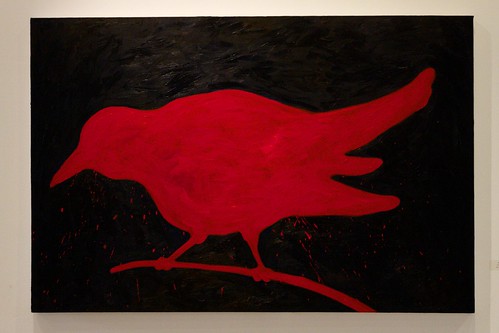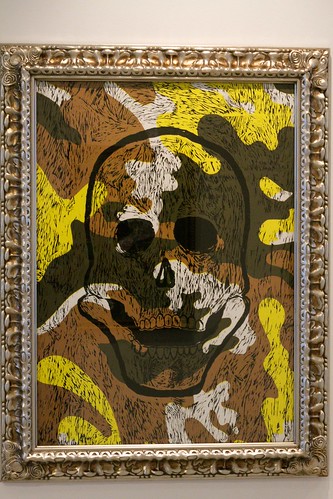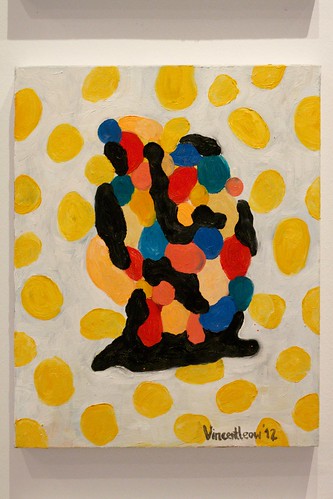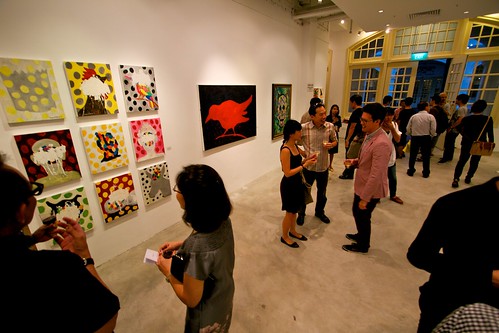Vincent Leow’s work spans many different media, but his practice is unified by a determined sense of humour, fictional speculation and whimsicality. For his latest solo exhibition at Chan Hampe Galleries, Vincent has presented a series of new paintings that were executed during his teaching residency in Sarjah, UAE. They feature various forms of otherworldly animals, creatures and humans, which are used to explore the notion of the familiar and foreign. I had the opportunity to speak with Vincent about his process and distinctive approach to his new series of work as part of Resembling Imaginary Creatures.
Joleen Loh: Mythology, legend and folklore have been used as ways to make sense of the world we live in or to account for human experience. You are simply not going to get this type of storytelling directly from science. In your practice, you have often borrowed from myths and folktales, and this is the same with your latest solo exhibition at Chan Hampe Galleries where you have employed them in your response to what you have seen during your residency in the Middle East. Can you start by telling us more about this?
Vincent Leow: I started exploring mythology, legends and folktales in the ’90s when I was travelling around Southeast Asia a lot, and what was very apparent to me was that these were a very big part of people’s lives there. In Hinduism and Taoism, for example, people worship and idolize mythological, half-human half-creatures like Sun Wu Kong and Ganesh. Some also relate to these figures as well as stories such as those in Mahabharata, and it’s a big part of their lives. When I started making that series of paintings informed by mythology, which were shown at the Singapore Art Museum, I wanted to create a sort of urban mythological creature using domestic animals – that is why I had Andy the half-dog half-human. That body of work was also inspired by Indonesian masks. There’s a particular mask, I can’t exactly remember its name now, but it was the face of a jester. I used that face as the head of the Andy creature to resemble a jester in society, and I used the dog both to reference the notion of the ‘underdog’ as well as the term ‘dog’ used to describe traitors. I also liked the way people connected with the creature in different ways. For my exhibition at the Singapore Art Museum, I revisited the Andy series of work again but, this time, I related it to current issues that surrounded me. For example, with the Andy series presented at the Venice Biennale, I wanted those stainless steel sculptures to appear kitsch to resemble cheap tourist souvenirs. With the Andy series, I was able to make a commentary on what was happening then. That’s how Andy kept resurfacing and I thought people responded to the body of work quite well.
JL: This body of work was also made in response to the political turmoil in the Middle East and the misrepresentations in the news and media. Where do you think the political moment lies in your work?
VL: The show was a little bit of both because the portraits of the skulls were the portraits of Andy. When he passed away, I wanted to make portraits in woodcut. These portraits were the result of that. As for the paintings, they were about a different encounter and experience in the Middle East. I wanted to explore aspects of abstraction in my work. I also wanted people to see things in an abstract form and then read it figuratively. I was telling someone about the painting of the bird. It was an image of a crow, which I’ve painted before in earlier works. This time, I wanted it to symbolize freedom, which is related to several protests for freedom and democracy in the Middle East as well as the violence and tragedies that happened there. The blood red that took over the black bird was one that expressed tragedy and one that, read differently, also makes the bird it encapsulates an auspicious one.
JL: Do you think that people who came to the show were able to identify the political in your new works?
VL: Actually, I have no intention for the works to be political. The works in the show are simply my reflection and response to certain events happening in the world. Despite all the things that are happening in the Middle East, Dubai is still unchanged and people don’t seem bothered by it. On the surface, everything appears fine and I think this has a lot to do with the way the media covers it. With the eight paintings you see on the left when you enter the gallery, I wanted to do a series of commemorative anonymous portraits of victims in Syria that were killed by the soldiers. It was a challenge for me to be able to make something that people can relate to even if they are anonymous or ambiguous subjects.
JL: Your images do have a playful and uncanny quality that seems counter to its content, but nonetheless draws you in. What do you feel is the role of aesthetics as it relates to your images? How is this considered when you construct your paintings?
VL: I want the materials in my works to be able to express certain emotions. I was very touched when a friend came to see my works and related a personal story to me. 20 years ago, she was shot in the face and this assailant reappeared in her dreams as a crow. She also mentioned that she forgave this person. She told me that the painting triggered that dream for her and she was very moved by it. And this is how I felt about painting and how it can trigger these emotions. If you look closely at the painting of the bird, the red is like a splatter. The strokes are emotional and I wanted to show that there is a price to freedom. It represents blood and is also an auspicious colour at the same time. I wanted the painting to have that tension.
JL: I’m interested in both your works of skulls. Coping with death can be very difficult for many people. It can be equally challenging to convey emotions caused by loss. Yet, you have developed a visual language that allows you to simultaneously address your personal dealings of loss and also, at the same time, make it rather playful. Has the process of creating these two works changed your feelings of death? Has it altered your thoughts on loss and the process of mourning?
VL: People tend to see skulls as inauspicious symbols – They aren’t good fengshui. I think the skull is a very powerful symbol, which has a strong historical significance. I was thinking about history and I was studying how different artists have depicted the skull as a subject matter – how Cezanne painted those three skulls, and Van Gogh and Rembrandt have as well. The skulls were a starting point to this series of work. I wanted to make works about the victims in the Middle East and people that have lost their lives in the Arab Springs. Those two skull portraits along with the other series with splashes of paint were both dealing with images of death but I didn’t want them to be stereotypically morbid depictions.
JL: They didn’t come off as just morbid. They were playful even…
VL: Yes I hoped that they would be funny and humorous. To me, I’m not afraid of death. As a Buddhist, I see death as a journey of life. The body is but a shell and the mind will continue to live on. When I express death, a lot of people find it very morbid but I think of it as a step to go forward.
JL: Your images are simultaneously humorous and sinister, familiar and foreign, instantly placing the viewer in the question-asking role. This prompts us to consider our own place in relation to the image, and how one’s own culture and daily activities can become key to interpreting these symbols. I feel that these effects are most profound in the portraits found in the group of twelve paintings of animals and silhouettes of anonymous figures, concealed either by colourful forms or white splashes of paint. How did you arrive at this? Can you talk a little bit about the choice to include real and unreal figures in the series?
VL: This presence of a form of veil and concealment in my paintings came from my encounters with students who wear veils. When I speak to them, I don’t know how they feel because I cannot see their face. I can only see their eyes. I don’t know if they’re laughing, if they’re sad or affected. I can’t really read their emotions. When I created that splash, my daughter asked why I destroyed it, why I had to splash paint over it. For me, that splash of paint is important because, in some ways, it puts us in a dilemma. What do you want to read from this painting? As I look at it each day, it grows on me. Each day I seek to find a reason as to why I do it. At the same time, when I first did it I was very intimidated. I wasn’t sure if it would work, and if it didn’t it would have destroyed the painting.
JL: In your new works, there is a consistent, almost obsessive use of black and colourful irregular spots throughout your paintings that either foreground your figures or are in the background. Although different, this reminded me of the repetitive polka dots in your previous works such as Mountian Cow Milk Factory and Dumbo back in the 1990s. Can you elaborate on the repeated use of these pictorial elements, and their mutations in this show?
VL: I painted dots in my earlier works back in ’91 when I was undertaking my masters. They were dots of colours like those on TV. The paintings I made were a combination of dots and using dots to distort images. Now, it has become a regular element in my work as I continue to introduce them in my paintings as a form of layering. It adds a dimension to the work and forms a kind of spatial dimension for the viewers. The dots are floating in front of the painting, creating a space in them which I enjoy. The changes in this series were intended as a way to be more abstract, and they have also become more pronounced since they are smaller paintings.
JL: Roland Barthes wrote that narrative is something that is present in all fables, tales and paintings. You can think of it as something that is present in all times, in all societies, and like life itself it is there – international, transhistorical and transcultural. Today, many contemporary folktales seek to deviate from the normal conventions mapped out by theorists that have sought to map out similarities in narratives across all cultures. Even though your work stems from a very personal experience, it also addresses ideas and employs symbols that are widely understood. However, ‘Eastern’ and ‘Western’ cultures often interpret ideas very differently. Do you feel that your works have been interpreted differently when exhibited to a Western audience as opposed to a local audience? Have you received very different responses in these contexts?
VL: I’ve always wanted to try a lot of different things. I didn’t want my works to be too localized. Even though I am inspired by ideas of the veil and elements of Islamic art, I try to look for ideas that will not be read in a specific way. It is important that the work itself can be read universally.
The exhibition Resembling Imaginary Creatures by Vincent Leow will be on view at Chan Hampe Galleries from 27 July to 21 August 2012.
Editor’s note: More photos of "Resembling Imaginary Creatures" available at our Flickr album. Words by Joleen Loh, photos taken by Eric Lim.

Artitute Contributors
Our art news contributors come from all walks of life. We are on the lookout for regular art patrons who write about the arts. Contact us if you would like to be a contributor on Artitute.com.





